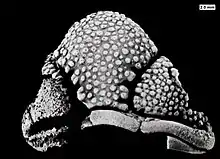Attawapiskat Formation
The Attawapiskat Formation is a geologic formation in Ontario. It preserves fossils dating back to the Silurian period.
| Attawapiskat Formation | |
|---|---|
| Stratigraphic range: Silurian | |
| Type | Geological formation |
| Location | |
| Region | Ontario |
| Country | |
Location
The Attawapiskat Formation encompasses a large portion of the Hudson Bay Basin. The formation remains visible from northern Ontario. A small portion of the formation does extend onto Nunavut territory.
Composition
It is widely believed that the formation originally deposited on a shallow rimmed shelf, followed by the development of barrier reefs into an nonlinear and uncoordinated "belt" around the Hudson Basin. Within the Hudson Bay Lowlands, the formation consists of dolomite and limestone rich in both coral and sponge. The formation is a haven for lithotopes, or media for sediments to deposit, with various types including:
- Mottled to Nodular Skeletal Wackestone
- Stromatoporoid-Coral Framestone
- Pelodial Intraclastic Bindstone
- Graded Oolitic Grainstone
The formation's depth reaches 62 meters at its deepest.
Fossil content
Color key
|
Notes Uncertain or tentative taxa are in small text; |
| Brachiopods | |||||
|---|---|---|---|---|---|
| Genus | Species | Presence | Material | Notes | Images |
| Eocoelia | E. akimiskii | Inter-reef beds of the formation, on Akimiski Island.[1] | Over 300 specimens.[1] | ||
| Erilevigatella | E. euthylomata | [2] | |||
| Gypidula | G. akimiskiformis | [2] | |||
| Meristina | M. expansa | Ekwan River.[3] | Now deemed a junior synonym of Pentameroides septentrionalis. | ||
| Pentameroides | P. septentrionalis | Ekwan River and Attawapiskat River.[3] | |||
| Protanastrophia | P. repanda | [4] | |||
| Reticularia | R. septentrionalis | Ekwan River.[3] | Now deemed a junior synonym of Pentameroides septentrionalis. | ||
| Sapelnikovia | S. (=Reveroides) norfordi | Attawapiskat River.[3] | Now deemed a junior synonym of Pentameroides septentrionalis. | ||
| Trilobites | |||||
|---|---|---|---|---|---|
| Genus | Species | Presence | Material | Notes | Images |
| Acidaspis | A. sp. | Ekwan River at portage at Strong Rapids.[5] | |||
| Chiozoon | C. cf. cowiei | Ekwan River at portage at Strong Rapids.[5] | |||
| Dicranopeltis | D. sp. | Ekwan River at portage at Strong Rapids.[5] | |||
| Ekwanoscutellum | E. ekwanensis | Limestone Island, Severn River.[5] | "Nested stacks of mostly inverted (concave-up) large sclerites, the majority of which are pygidia".[6] | A scutelluine. | |
| Meroperix | M. aquilonarius | Ekwan River at portage at Strong Rapids.[5] | [6] | A scutelluine. | |
| Opoa | O. sp. | Ekwan River at portage at Strong Rapids.[5] | |||
| Perryus | P. severnensis | Limestone Island, Severn River.[5] | Several cranidia, pygidia and disarticulated exoskeletons.[5] | An encrinurid. |  |
| Stenopareia | S. sp. | Ekwan River at portage at Strong Rapids.[5] | [6] | An illaenid. | |
References
- Jin, Jisuo (September 2003). "The Early Silurian brachiopod Eocoelia from the Hudson Bay Basin, Canada". Palaeontology. 46 (5): 885–902. doi:10.1111/1475-4983.00324. ISSN 0031-0239. S2CID 129391469.
- Jin, Jisuo (2005). "Reef-Dwelling Gypiduloid Brachiopods in the Lower Silurian Attawapiskat Formation, Hudson Bay Region". Journal of Paleontology. 79 (1): 48–62. doi:10.1666/0022-3360(2005)079<0048:RGBITL>2.0.CO;2. ISSN 0022-3360. JSTOR 4094960. S2CID 131483013.
- Jisuo, Jin; Copper, Paul (2011-02-08). "The Early Silurian brachiopod Pentameroides from the Hudson Bay Lowlands, Ontario". Canadian Journal of Earth Sciences. 23 (9): 1309–1317. doi:10.1139/e86-126.
- "A new genus of Late Ordovician–Early Silurian pentameride brachiopods and its phylogenetic relationships - Acta Palaeontologica Polonica". www.app.pan.pl. Retrieved 2022-08-23.
- Gass, Kenneth C.; Mikulic, Donald G. (1982). "Observations on the Attawapiskat Formation (Silurian) trilobites of Ontario, with description of a new encrinurine". Canadian Journal of Earth Sciences. 19 (3): 589–596. Bibcode:1982CaJES..19..589G. doi:10.1139/e82-047. ISSN 0008-4077.
- Westrop, Stephen R.; Rudkin, David M. (1999). "Trilobite Taphonomy of a Silurian Reef: Attawapiskat Formation, Northern Ontario". PALAIOS. 14 (4): 389–397. Bibcode:1999Palai..14..389W. doi:10.2307/3515464. ISSN 0883-1351. JSTOR 3515464.
- Various Contributors to the Paleobiology Database. "Fossilworks: Gateway to the Paleobiology Database". Retrieved 8 July 2014.
- Ramdoyal, A., Nicolas, M.P.B. and Chow, N. 2013: Lithofacies analysis of the Silurian Attawapiskat Formation in the Hudson Bay Lowland, northeastern Manitoba; in Report of Activities 2013, Manitoba Mineral Resources, Manitoba Geological Survey, p. 144–155.
- Gass, Kenneth & Mikulic, Donald. (2011). Observations on the Attawapiskat Formation (Silurian) trilobites of Ontario, with description of a new encrinurine. Canadian Journal of Earth Sciences. 19. 589–596. 10.1139/e82-047.